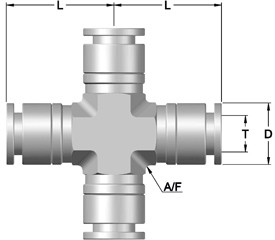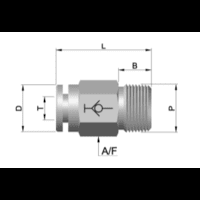
A Handy Guide to Stainless Tube Compression Fittings
March 30, 2022
Understanding Pipe Couplings and Their Specific Applications
June 3, 2022Almost all of the primary industries use process measurement and control instruments. Aerospace and defense, power generation; chemical processing; oil and gas; petrochemical; alternative fuels, shipbuilding; and medical equipment.
Instrument valves and fittings include everything from control valves, fittings, and tubing to flow meters, pressure sensors, and level gauges, which are all part of this group. They are used to move, measure, and control the amount of flow, pressure, and temperature in a system and calibrate the system. Instrument pipe fitting is critical to the workings of a plant or a group of products. In the instrumentation system, the veins and arteries are the parts that connect the parts.
Instrumentation Fittings
Tube Fittings
In general, four main fittings go from high to low pressure in tubes. They are different because they connect and what they can be used for.
Compression Fittings
Compression fittings are the most common and easiest to put in. This design has a series of grips on the tube. Compression fittings are three parts: a nut, a body, and a ferrule. The tube’s ferrule coins have a firm grip on the tube’s surface. Over C&T fittings, compression fittings are better at absorbing vibrations. But over butt weld fittings, compression fittings are better.
These tools and equipment are not needed for this type of fit. A box wrench can tighten the tubing to the correct torque. Because compression fittings are easy to put in, they are usually the cheapest part of the whole thing to put together.
Compression fittings also work well with tubing with a thinner wall, allowing for faster flow rates and making it easier to bend and handle. When compression fittings are used with stainless steel tubing, they can let up to 33% more flow through the tubing than if they were used with the same size C&T.
Cone and Thread Fittings
They are sometimes used for very high pressures, but they are usually used for pressures of up to 15,000 PSI. They are solid and secure because the tube is chamfered and sunk into the fitting. For a tight seal, the ends of the tubes must be made with precision and have a smooth surface finish.
The tubing must then be threaded to be firmly pushed against the joint. This is usually done in the field, which adds a lot to the time and cost of installing C&T fittings. Because compression fittings can be broken down and put back together for maintenance, C&T fittings can also be broken down and put back together.
These steps are not always repeatable or stable. They can also get metal shavings and cutting oil into the tubing ID, which will need to be cleaned again. A lot of training is needed to use the tools needed to install C&T fittings. In addition, because the joints are threaded in places that are not controlled, the instrument pipe fitting can come loose when they’re shaken around a lot.
Butt Weld Fittings
Some studies have found that there is at least one vibration failure for every three corrosion failures in the field. This means that when C&T instrument pipe fitting is correctly installed, they still make a solid connection. The butt weld fitting is the best way to protect against vibration. It is best to have a well-formed butt weld because the metals will be permanently joined together. However, a butt weld fitting connection still has some drawbacks, such as the cost of making it. It can be more expensive to make a butt weld connection because of the cost of welding equipment, a specialized welder, and the extra time it takes to make the connection.
The field maintenance of fluid systems can be difficult or impossible with butt weld fittings because the joints may be hard to reach, or the maintenance crew doesn’t have the right tools or skills to cut and re-weld them.
Push-To-Connect Pneumatic Fittings
Push-to-connect fittings have an internal collet and an outside push button, making it easy to connect tubing. These instrument valves and fitting are made of poly or nickel-plated brass, resin, and polyoxymethylene plastic. Polyurethane or nylon tubing can be used with push-to-connect air fittings, ensuring that all pneumatic connections are leak-free and secure. Push-to-connect pneumatic fittings make it easy to connect and disconnect pipes with no tools. You push the tube into the fitting and pull it out.




